





















































































































































































































































































































































































































































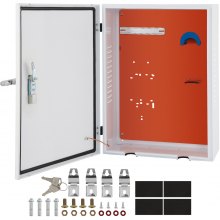
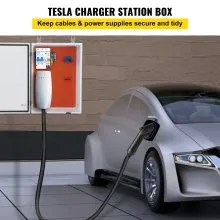
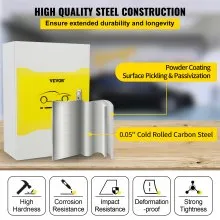
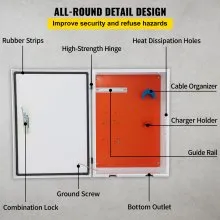


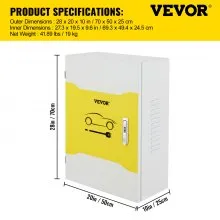
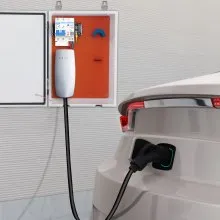









































































































































The current power system would only be complete with electric transformers, which are crucial for providing a consistent and effective source of electricity to residences, companies, and industries. An essential component of success in today's quickly changing corporate environment is the effective and dependable management of electrical power.
Electric transformers made by VEVOR have become a revolutionary alternative for companies trying to improve their power infrastructure. These cutting-edge electronic transformers offer a flexible solution to meet a range of operating requirements in addition to a trustworthy and steady power supply.
Electric transformers have been a vital component of electrical power distribution networks for homes, businesses, and industries for over a century. Electric transformers improve the efficiency of electricity distribution since, without them, it would be essential to reduce the range between power stations and various consumer kinds.
The primary winding, secondary winding, and magnetic core are the three main parts of an electric transformer. Physics-wise, electrical transformers function according to Faraday's Law of Electromagnetic Induction, which states, “The rate of change of the flux linkage with respect to time is directly proportional to the induced electromagnetic field in a coil or conductor.”
Therefore, the interaction of electromagnetic induction among two circuits connected by a shared magnetic link drives an electrical transformer's operation. Energy is transferred from one location to another with the aid of the mutual induction that occurs between these circuits.
The primary winding is the winding that generates the first magnetic flux and is coupled to an electric source. The two coils are not connected. In order to improve the links or connection, the first electric flux is generated in the primary winding, through which the magnetic core flows and is coupled to the supplementary one in regard to low reluctance.
The core acts as a bridge, redistributing the electrical current to the secondary winding to complete the current flow across a magnetic circuit. It should be noted that in some types of transformer flux, when each winding is wrapped on the same core, the secondary winding can reach an impulse, producing movement by the created magnetic field.
Electronic transformers come in several varieties, each serving a distinct classification based on features or uses. Considering there are many different kinds of electric transformers on the market and listing them all outside the scope of this article, we will only briefly discuss a few of the more important ones.
One of the primary and most often utilized transformers is the power transformer, which is used extensively to adjust voltage in substations and power plants. Due to their great degree of internal insulation and the fact that they are huge and heavy, they are typically used at full load and high voltages.
Since their design guarantees an ultimate efficiency of 100%, these are typically put in generating or transmission facilities. They are larger than distribution transformers; however, because of the extremely high voltage these transformers create, they cannot be distributed directly to the users.
As their name suggests, step-down transformers are exactly the opposite of step-up transformers. The transformer can change low current into higher current and high primary voltage into low voltage. A step-down transformer's number of windings varies from its counterpart since it converts voltage in a parallel fashion.
Specifically, this means the secondary windings have fewer turns than the primary windings. In circulation networks, step-down transformers are primarily used to convert high grid voltage to a smaller voltage that may be delivered to individual residences.
Low voltages can be converted to high voltages and high current ACs to low current ACs using a step-up transformer. Fewer turns are found in the main winding of a step-up transformer than in the secondary winding.
A step-up transformer increases the secondary voltage to the main voltage ratio. These step-up transformers are found at power stations wired to a generator's transformer connected to the grid.
The basic parameters of an electrical transformer, including its primary and secondary voltages, cooling techniques, KVA, power factor, winding conductor material, types, mounting configuration, winding connection, efficiency, and operating frequency, must be determined to select and size the electric transformer.
The nameplate, a plate installed on the transformer, has all these parameters listed. Any electronic transformer thoroughly inspected will have a comprehensive sticker that fits perfectly and includes all of the transformer's specifications.
It is essential to calculate the KVA while choosing and sizing transformers. This is the apparent maximum power that a transformer is capable of handling. Power factor, current, and voltage all affect KVA.
An electrical transformer is a device that operates on the electromagnetic induction principle. This gadget lets you adjust the voltage and strength of an alternating electric current while maintaining a steady power supply.
Since high voltage is the most effective means to carry a voltage from an electrical plant, these machines play a significant role in the security and effectiveness of long-distance energy distribution systems.
Regarding company powering, VEVOR Electrical Transformers are the best option available. They are a crucial investment because their precise engineering guarantees safe, effective, and dependable electrical transformation.
VEVOR Transformers provide unrivaled performance, lifespan, and versatility with a dedication to quality and innovation, guaranteeing your business's efficient and economical functioning. Select VEVOR to give your company the transformative power it deserves.
The primary winding, an insulating material, secondary winding, and magnetic core are the three main parts of an electric transformer.
A transformer's efficiency is defined as the output power divided by the input power, much like any other electrical machine. The electrical equipment with the highest efficiency is transformers.
When electrical electricity moves from an energy provider to a workplace, residence, or other location, a power transformer is used in the power supply to enable access to the power. Energy is lost when energy is transferred from an electrical facility to a customer via transmission cables.
Always put safety first by ensuring equipment is properly grounded, preventing overloads, and using caution when handling high-voltage transformers.